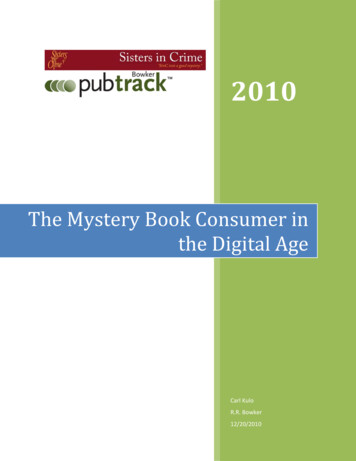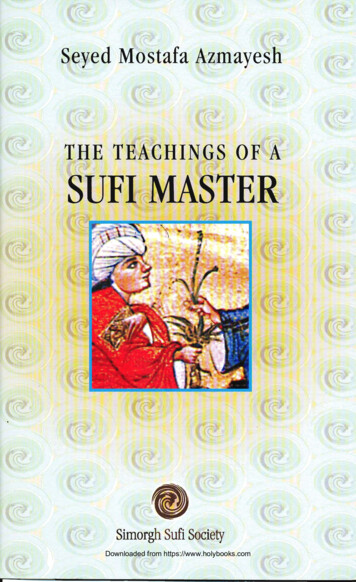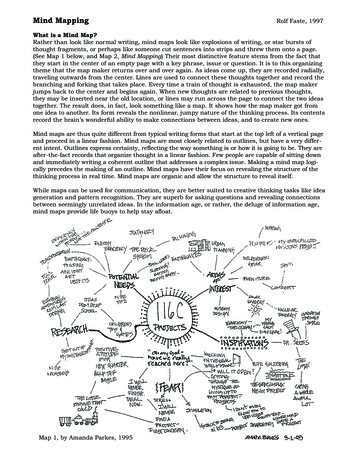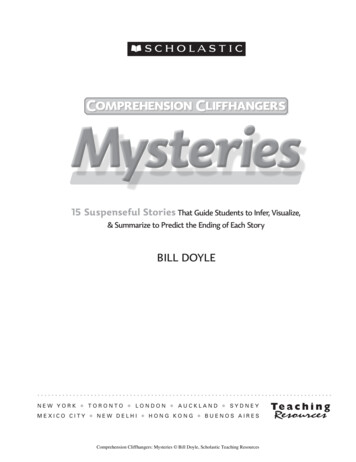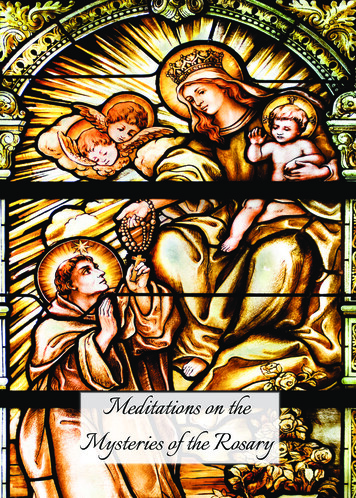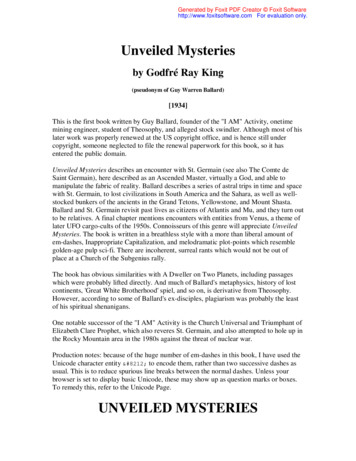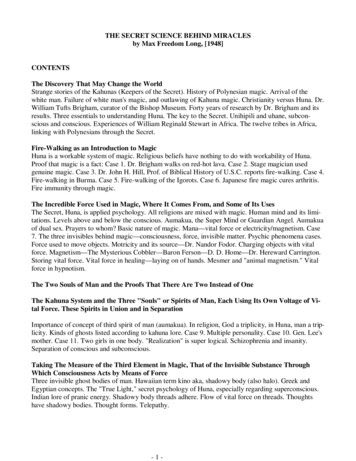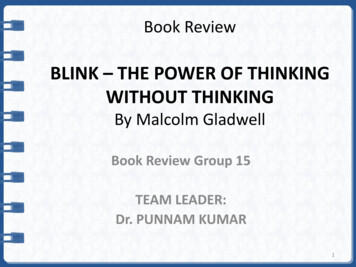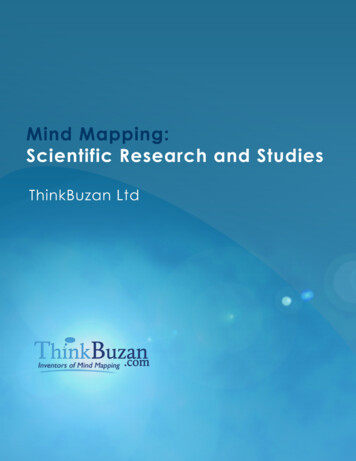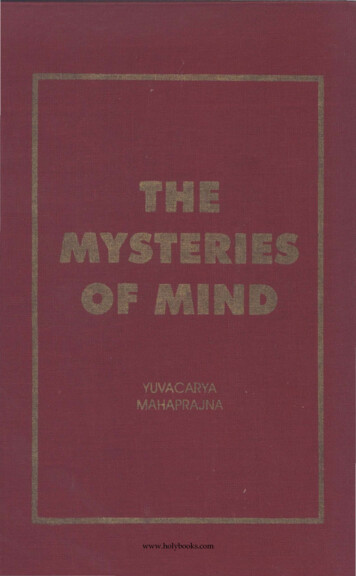
Transcription
www.holybooks.com
THE MYSTERIESOF MINDYUVACARYA MAHAPRAJ:F:IATta11s'ated into Englijh byKL. GOSWAMIPublished under the auspices ofJA[NA VISHVA BHARATJ, LADNUN-341306RAJASTBAN, INDIAToday & Tomorrow's Printers and Publisherswww.holybooks.com
COPYRIGHTS tODAY&TOMORROW'S PRINTERS&PUBLISHERSNEW DELHIFirst Published 1982Edited by:MUNI DULAHARAJ (Hindi Edition)MUNI MAHENDRA KUMAR (English Edition)ISBN : 0-8806 5-223-3Distributed in USA and Canada by ·SCHOLARLY PUBLICATIONS7310 El Cresta DriveHOUSTON, TEXAS 77083Composed by : B.N. PRINTERS4240, Budh Nagar, Rampura, Delhi-110035Printed at : Mohan Printing Corporation, Padam Nagar, Delhi-110007Published by: Shri R.K. Jain : Today & Tomorrow's Printersand Publishers, 24-B/5, Desh Bandhu Gupta Road,Karol B agh, New Delhi-110005www.holybooks.com
CONTENTSPageI. New Dimensions of Perception1-81Search for existence : Right visionDevelopment of the force of resistance-SelfdisciplineThe playground of consciousness - Freedom fromself-negligenceTransformation of personality- EquanimityDevelopment of energy-TapaThe upward flow of energy26374554Spiritual joySearch for truth6373II. Awakening of Energy11682-165Awareness of responsibilityAwakening of energy-Value and purposeGuidelines for arousing energyAnalysis of the gross and the subtleRelief from mental tensionsMental balance828897107117125Spiritual pilgrimageLet us search truth ourselvesStruggle for freedomConsummation of Sadhana133143152159III. Mental Training166-242The third area of consciousness-EquanimityDevelopment of mental powers and their usewww.holybooks.com16617 l
ivPageMental powers and Samayika179The bliss·giving flow of energyAcquisition of a new personality1861S3Mental healthPrek a meditation and the training of the mindThe journey of consciousness : the unknown destinationThe secret of the life of the spirit201209226Spiritualism and ethics234Prek a meditation - 238
PREFACEIt takes a long time for the seed to grow into a tree.If it did not sprout, we will be deprived of the benefits wereceive from the tree. We get flowers, leaves, fruits, shadeand fuel only when the seed has sprouted and grown into atree. Consciousness also has to perform a Jong journeybefore it can attain its hhhest development. If it remaineddormant, we shall not be able to receive from it that whichwe expect to receive. Friendliness, peace, sympathy, goodwill, equanimity and synthesis are the consequences of arousedconsciousness only.In order to arouse consciousness we have to carry ourenergy to the upper parts of the body. When it descendsinto the lower parts of the body, it excites sex-consciousness.Knowledge and consciousness can be developed only whenenergy is carried upwards. Meditation is an attempt tocarry energy upwards. The present book deals with some ofthe aspects of the upward movement of energy.P, l\ ii meditation camps are being organised from timeto time. These camps provide exercises in meditation as well asdiscussions on the subject of meditation. This book is a compilation of such discussions. It includes discussion which tookplace in the camp; organized in October 1977, March 1978and June 1978. The practice of meditation introduces thepractitioner to his self. He establishes dired contact withwhat happens in him. Discussions on meditation cire muchhelpful in this respect. Knowledge of pl1ysiology and anatomy is essential for a physician as well as for a meditator.Their purposes may differ. Knowledge of the body is essential for the meditator in order that he may be able to perceiveits parts and touch and activate every cell of it with consciousness.www.holybooks.com
viKnowledge of psychology is as essential for the meditatoras it is for the psychologist. Unless the prek,va-meditatorknows the different strata of consciousness, he cannot activatethe powers of the psyche. The purpose of meditation is toarouse and develop the powers of the psyche.Knowledge of karma sastra is as essential for the meditator as it is for the philosopher. The meditator cannotsubdue the waves produced by the fruition of karma withouta knowledge of the nervous system. Prek,va meditation makesthe mind wakeful. The wakeful meditator can feel all thewaves of excitements and passions arising in the nervoussystem and render them inactive through perception.We are a ware of the power of thoughts, but we areunacquainted with the power of perceptwn. Thinking tiresknowledge-tissu s whereas perception energises and activatesthem. Perceptive consciousness is natural. In whatevtr partof the body it enters, consciousness releases the current ofvital energy in it. The tlow of the current of vital energyin sufficient quantity arouses the dormant centres of consciousness in the body. The pn cess of the arousing of theconsciousness-centres has been briefly touched upon in thisbook.Acarya Tulsi was kind enough to comment upon thediscussions in the camps on the closing days. These commentswill be separately published. I have been highly benefittedand inspired in my discussions on meditation by the Acarya.Muni Dulaharaja took great pains in compiling the discussions in the form of the manuscript copy of this book whichI appreciate.On the basis of the views expressed by the readers onour books on meditation published recently, the interestevinced by them in reading them, and their efforts for implementation of the ideals contained therein, we feel that brightpo5sibilities are emerging in this field. I wish that everyhuman being may be blessed with the feelings for spiritualism.Let everybody know his 'self' and realize it. I once more bowreverentially to the Acaryasri and wish that the path of thehumanity at large may be illumined through his guidance.Marwar RanaviisaAugust 15, 1982-YUVACARYA MAHAPRAJivAwww.holybooks.com
INTRODUCTIONPractitioners come to the siidhanii camps empty-handedand return with their hands full. We may also say that theycome to the siidlza11ii camps with their hands full and returnempty-handed. Both the statements are correct. Practitioners join the camp after having emptied themselves of allthat is to be relinquished and return full of spiritual strength.Spiritual exertion is a means of emptying the mind and also ofproviding a lot of energy to the participant. That which isunwholesome has to be discarded and that which is wholesomebas to be preserved and enriched.Every participant in the camp for exercises in prek iimeditation must wholeheartedly adopt the following guidingprinciples of prtk(fii meditation. They should recite theseloudly:1. I present myself for exercises in pr k ii meditation.2. I have adopted the path prescribed for prlk i'i. medi·tation or spiritual stidhanii.3. I accept the merits of insight.4. I accept the merits of spiritual experiences. Bhiivakriyii., the psychic coun erpart of material action, isthe beginning of perceptive meditation.It means three things :1. To live in the present moment.2. To do things wakefully, and3. To remain constantly self-watchful.Most of our life is spent m involvement in our pastdeeds and in worries regarding the future. Ninety percentof our lives is covered by the awareness of the past andwww.holybooks.com
viiiof worries about the future. Only ten percent of them is spentin the present. The past is no more real and the future hasnot yet materialized. The past is mere memory and the futurea thing of imagination. The present alone is real. We spendvery little time in living in the present. Mostly we remainentangled in the memories of the past and in dreaming whatis likely to happen in the future with the result that we loseour grip on the present. We cannot retain it. The fact,however, is that whatever happens in life happens in the present only. But we are not wakeful about this fact. Bhiivakriyii means living in the present.The second meaning of bhiivakriyii is to do deedswakefully. We do things half-heartedly or with half of themind engaged elsewhere. Work done with only half of themind in it is never done completely. In this way we lose a lotof our energy.Things done half-heartedly do not produce tangibleresults. We should physically as well as mentally engageourselves in our deeds earnestly and sincerely. While doingdeeds the mind and the body should cooperate with eachother.The third meaning of bhifrakriyii is to remain constantlywakeful. The practitioner should remain fully consciousof the ideal he wants to achieve. Purity of heart is theprecondition of meditation which aims at arousing the dormant energy in us. The practitioner should be constantlywakeful about these.The second principle cf pr't!qii meditation is not toremain inactive but to remain active. Most of our life consists of reactions rather than of actions. Most of our actionsare mere reactiom. Take for example the wearing of clothes.We wear clothes as a reaction against cold or as a reactionagainst being indecent. Eating food is a reaction againsthunger. Eating, drinking, clothing etc. are not voluntaryactions but reactions. What we need is to live a life ofactions rather than one of reactions only. Every man has hisown free aud independent life. This free life can be maintained only by actions done freely or of one's own free will.A life of reactions is not a free and meaningful life. It is awww.holybooks.com
ixdenial of freedom. We should be free and conscious agentsrather than toys which simply react. Action and not reactionis the watchword of siidhanii.The mind of the modern man is not free. He simplyreacts to situations and circumstances. He does not act.Actions done under the impact of emotional situations arealso reactions and not actions. The entire activities of thesense-organs are reactions. We hear and see things underthe influence of our predilections. Instinctive actions arealso. reactions.Friendliness is the third principle of perceptive meditation. The whole behaviour of the practitioner should begoverned by the spirit of friendliness. He should maintain theesprit de corps. His actions should be the expression of thedeveloped attitude of friendliness towards every living being.Even when bitten by a nake, he should behave with it in afriendly way thinking that it has bitten him out of ignorance.This is possible only when he does not react to a situation butacts wakefully. Compassion for all living beings is the consummation of the spirit of friendliness. 'An eye for an eye and atooth for a tooth' is a philosophy tot,dly incompatible withthe spirit of friendliness. He alone who has become consciousof his free existence will avoid reacting and will act of his ownfree will.Restraint in matters of food and drinks is the fourthprinciple of prek ii meditation. Food not only affects health, italso influences the mind, meditation and consciousness. Mostlywe eat unnecessary things. Food habits arc governed by socialand geographical conditions and traditions and customs. Eatingtoo much or more than what is necessary produces deformities because it cannot be properly digested. Most of it goeswaste. It accumulates poisonous waste-products in the intestines. It affects our minds and thoughts adversely. It alsoclouds our consciousness. If the nervous system is not trimmed and clean, mind and consciousness will not remain pureand our energy will not be increased. If a looking glass isnot clean it will not reflect anything clearly. The reflectionof cpnsciousness will be obstructed if the nervous system andthe i testines have been blocked and the light of consciousness will remain hidden within the body. Those who havewww.holybooks.com
Xdeveloped a strong liking for delicacies and who keep theirminds unclean will always remain careless about what theyeat. For them the pleasures of the palate are supreme pleasures. Those who want to use their minds the kast, thosewho want to activate the energy lying dormant in them, thosewho want to put their powers to maximum use and thosewho are ambitious to do great deeds will never be carelessabout and negligent in matters of food. Enlightened meneat only to nourish their bodies and not to satisfy thdrpalate.The practitioner of sddhana has to walk on a selectedpath. His aim is to activate his energies, to achieve something commendable, and therefore, he must know what kindof food prvdUCt'S what kind of consequences.The fifth principle of perceptive meditation is to speakvery little or to remain completely silent. We have to speakbecause we live in a society. Language is an instrument ofsocial communication. But siidhanii, being a personal affair,needs little speaking. I do not mean that the practitionershould never speak in his life-time. He should certainly avoidspeaking too much or when it is not needed. Even when hehas to speak, he should speak very little and that too softly.He has to communicate mysteries, and therefore, he shouldspeak very softly and preferably in the ears of the listener as ifhe is talking something secret.The entire life and behaviour of Bbagavan Mahavira is anexample of comp1ete silence. He spoke very little. I do notmean that he did not speak at all. That is why his actionsremained undisturbed and b'! could preserve immense energy.Some people take the vow of silence, but thoughts rise thicklyin their minds and they are unable to control them. Theywrite out thousands of pages to express themselves. This goesagainst the very vow they have taken. Their entire energy isspent in writing or in making physical gestures. This is afoolish waste of energy.The above-mentioned principles of pr'ik ii meditation,when practised, give the practitioner a lot of gain.In sadhana the practitioner should be very clear abouthis aim from the very first day on which sadhantl begins.www.holybooks.com
xiThe first step in sddhanii is the purification of the mind.The mind is polluted by passions. The current of knowledgecannot flow freely in a polluted mind. As soon as the mindhas become pure, the curtain obstructing the manifestation ofknowledge is lifted and the self is enabled to see through themind. We experience a state of calm when the mind has beenpurified. In such a state the mind becomes balanced and fullof the feelings of friendliness and joy. Joy manifests itself assoon as the taijasa energy is released in the mind of the practitioner. Tejo /Myd gives joy, padma llsyd produces calm andsukla l'Hyd eradicates passion .Our aim at present is to purify the mind and not toattain joy. Joy is not the ideal. lt is a support. We willhave to go ahead.We should contemplate before we begin to meditate.Bhiivanii is a shield which protects us on all sides. It doesnot allow external influences to disturb us. How to buildthe shield ? It can be built by reciting the sacred wordArham in a sitting posture. While reciting it, we shouldimagine that a glow of light is spreading all around us, thatit is growing stronger and that a shield of light is in themaking. In the course of a short time the practitionerwill begin to feel that a shelter is being built around himwhich is two three feet deep. Bhiivanii is the base of yogicpractices.To sum up, the prerequisites of the practice of prtk iimeditation are :1. To accept the five principles of prlk1a meditation,2. To build the image of the ideal, and3. The application of bhiivaniia.www.holybooks.com
www.holybooks.com
LECTURE ONEISYNOPSIS*0 patient one ! Try tofestation of suff::ring.understandthe root and mani-*You will see that those who lack self-knowledge becomea prey to suffering.* I say : Look at the tortoise and its shelter. The tortoisehas his mind in the opening in the shelter which is coveredwith sevala and lotus leaves. It is not prepared to enterinto its hole because it is inclined towards the open sky.* I knew that in order to live a successful life you wouldlike to have :HealthLongevityJoyPeace*There isThere isThere isThere isnonononopeace without discernment.joy without peace.health without joy.longevity without health.* In order to obtain this you have to begin your life anewand in a new style. For some time you will have to followthe footprints left by others and then you will have to flyin the sky where there are no footprints. This new phase ofyour life is not a phase of thinking but of perceiving andnot one of argumentation but of experience.* Self-discipline is a siidhanii (exertion) which results inimmunity from the influx of fresh deeds into the soul.* Tapa (penance) is a siidhanii (spiritual exertion) whichresults in a complete eradicationdeeds.of the effects of pastwww.holybooks.com
THE MYSTERIES OF MIND* Renunciation of activity is a sii.dhanii which results in theattainment of spiritual powrrs.* Conscious dissociation from past deeds produces discernment and intuitive knowledge.* Mostly people live a life of delusions. Lack of di cernmentis a deep-rooted torpor which makes us self-forgetful.* Deployment of the forces of delusion:* The first line of defence---passions.* The second line of defence - sleep.* The third line of defence- lack of self-discipline, waywardness of the sense-organs and the mind, and theirfickleness.* The fourth line of defence -lack of discriminationregarding what is beneficial and what is not, pervertedvision and lack of wisdom regarding joy and suffering.* The attainment of discernment is the first assault on thedefence lines of delusion.* We have assumed attachments and aversions to be ournatural tendencies. We have assumed anger also to beour natural tendency.* Pride, deceit. greed, hatred, fear -- we have assumed theseto be our natural characteristics. This is delusion.* Discernment enables us to understand their real nature.* How can attachment which produces pain be thecharacteristic of the soul ?* How can aversion which produces pain be the cbaracteristic of the soul ?* How can anger \-·hich produces pain be the characteristic of the soul ?* The exercise of Kiiyotsarga (abandonment of the body).* The body is an insentient entity. The self is not thephysical body.* Breath is an insentient entity. The self is not breath,*The sense-organs are insentient entities. How can thethe soul be the sense-organs ? The mind is material. How can the self be the mind ?www.holybooks.com
3SYNOPSIS* Speech is a material process.speech ?How can the self be* Man can see his real existence only after he has cuthimself off from the above. The self lies beneath them.* Five resultants of Right Perception :* Peace, Sense of freedom. Non-attachment, Tolerance,Dedication to truth."' The soul perceives itself :* Vibrations of breath- a part of the soul.* Vibrations of the body-a part of the soul.* Vibrations of the mind- a part of the soul.* Vibrations of feeling- a part of the soul.* After these the aura, then perception of priiTJ,a (vitalenergy) and then perception of consciousness.*Who is the perceiver ? What is the object ofperception ?* Consciousness is divided, and, therefore, subtle consciousness is the perceiver and gross consciousness isthe object of perception.www.holybooks.com
:l :SEARCH FOR EXISTENCE: RIGHT VISIONWe have begun a pilgrimage today. We have also chosena path for it. Every one walks on some path or the other. Wetoo have been doing so. Every path is paved with footprints,but ours is a path which has no footprints. Footprints on apath suggest that someone has already walked on it and we aretempted to follow the footprints. The absence of footprints onour path means that we are not going to follow anybody. Oursis a path without footprints, and, therefore, there is noquestion of our following anybody.Thoughts leave their traces on the mind. Actions whichwe had done in the past have also left their traces on our mindswhich assume the form of habits or predilections. Wordswhich we speak or hear also do the same. Thoughts, actionsand words disappear but the traces they leave on our mindsremain active.There is no possibility of our following or imitating anybody because we have chosen a path which has no footprints.Those who walk on other paths get attached to their own wayof life, and, therefore, leave their traces and footprints behindthem and others of the same nature imitate and follow them.Their lives are lives of indulgence. On the other hand, thosewho walk on this path which we have chosen for ourselves areaspirants who have given up all kinds of attachments, and,therefore, have not and will not leave any traces or footprintsbehind for others to imitate. The pilgrim on this path will haveto rely on his own resources and exertion. A path on wl1ichthere arc no footprints is the best path because it is free fromall the traces of the past which might divert the attention ofthe pilgrim.Our only aim in walking on this path is to gain insight.www.holybooks.com
SEARCH FOR EXISTENCE : RIGHT VISION5Therefore, let us see; let us look within. Let the soul see itselt.This may appear to be something queer. What is the soulwhich perceives itself? Who is the seer and what does he perceive? It is a perplexing question. The amwer is that when thesoul becomes divided, one part of it becomes the seer and theother part the object of perception.See your breath. See your mind. See your body. See thelife-force in you. See your aura. I am sure you would like toknow if your breath is your soul. Perhaps you would also liketo know if your body is your soul. You may very well ask ifyour mind or the aura which surrounds your body and whichis generated by your body or the vital force in you is yoursoul. If you thought over these questions a bit seriously, youwill come to the conclusion that your breath, your body, yourmind, the aura emanating from your body and the vital forcein it are your soul. If the vital force in the body were not thesoul, we will not be able to distinguish between a living and adead body. If the living body were not the soul, we shall notbe able to distinguish it from dead body. If the mind were notthe soul, there will be no difference between thinking andnon-thinking beings. Every one of these is, therefore, thesoul.We cannot understand the body correctly if we did notfeel and understand breath. We cannot understand themind without understanding the body. We cannot perceivethe aura around the body without understanding the body.We cannot understand the vital force until we have seen andknown the aura. We cannot come across the conscioussubstance which is the end of our journey until we have knownand understood the vital force. This is the span of ourjourney. We will have to traverse the entire course in thevery order given above in order to arrive at the stage of selfrealization, at that which is the subtlest, ie., at our Existence.Breath is the first window through which you canperceive the soul. It is by passing through this window thatthe journey towards the self begins. It is a journey within.It is a journey towards self-perception. Normally we areaccustomed to looking outwards only. It is the nature of themind to run towards the external world only. Breath is thefirst door you have to enter into before the journey withinwww.holybooks.com
6THE MYSTERIES OF MINDbegins. When the mind begins to follow the in-going breath,we begin to enter into our being. Breath is the soul. Thebody is the soul. The mind is the soul. We can reach thefag end of our journey through them only.It is a delusion to desire to see the soul directly. Thesoul which is the supreme reality, the supreme existence andthe subtlest entity cannot be an object of perception by thegross sense-organs. To say so will be a great mistake.To say that we should try to see the soul through thesoul means, firstly, that we should first engage the mind inperceiving the vibrations of breath. Secondly, it meansengaging the mind in perceiving the vibrations of the bodyand sensations. Thirdly, it means watching one's own thoughtprocesses. Once you have gone through these three stages,you will encounter the aura around the body and get a chanceto perceive it.The somatic and extra-somatic atmospheres in the midstof which we live are full of vibrations. Those who havehappened to see the aura feel that in doing so they werefloating in an ocean of vibrations whose expanse they areunable to imagine. Having seen the aura we will beable to come in contact with the vital force. It is the vitalenergy which is the source of all the internal and externalvibrations.Breath is not the soul. The body is not the soul. Themind and the aura are not the soul. It is the vital energywhich soaks breath, mind and body in the soul so much sothat they become the soul. The body which comes in contactwith the life-force and becomes permeated with it becomesalive and a part and parcel of the soul. When the vital forcecomes to establish a relationship with the mind, the mindbecomes activated. The vital force when it comes to be associated with breath, activates the latter. Breath begins tovibrate because of this association. It is the vital energywhich makes the heart throb, the breath vibrate, the mentalprocesses begin and the spectrum of the aura radiate. Theever-flowing stream of consciousness is the source of the vitalenergy. Vital energy inducts life in the entire structure of thebody and transforms everything which is non-soul intoconsciousness,www.holybooks.com
SEARCH FOR EXISTENCE : RIGHT VISION7To understand breath is the first stage in the process ofsiidhana which culminates in the perception of the soul. Tounderstand the body is the second stage. To understand thethought-processes is the third stage. To understand the aurais the fourth stage. To understand the vital force is the fifthstage. Self-realization is the end of these stages.When I 5peak of seeing the soul through the soul, I meanproceeding from the gross to the subtle. Nobody who hasnot understood the gross can comprehend the subtle. Everystage of our pilgrimage is a stage which leads us to thecomprehension of the subtle. Ordinarily we keep ourselvesconfined within the four walls of sensations, but once the mindhas been properly trained, we begin to sense the subtle also.An untrained mind can only feel the gross sensations. Assoon as it has become refined and subtle, the stream ofconsciousness begins to reveal itself.The beating of the heart and the circulation of bloodand air in the body keep it working like a huge factory. Andwe remain unconscious of what is happening in the body. Thereason for this is that we are incapable of seizing the sensations. It is only when we watch very carefully that we areable to see how much the body is seething and throbbing withactivity. It is only when we perceive the body that we cometo know that the pulse and the heart are beating and that theblood is circulating in it. Our minds have become so grossthat we are unable to comprehend subtle thing . We cancomprehend subtle entities through the subtle mind only.Siidhanii consists in refining the mind and making it subtle.The more the mind becomes refined and subtle, the nearershall we arrive to our subtle being or Existence. Grossersensations will then disappear and we shall be in a position tocomprehend more subtle or finer sensations.What is the consequence of comprehending the mind ?It results in self-discipline. We have chosen a path which hasno footprints. There is no question of following and imitatinganyone. Once our walking has gathered momentum, we willbegin to command a comprehensive and disciplined orientation or vision. The mind will then stop wandering aboutoutward things. Jt will fix itself on one point only and aone-pointed consciousness will emerge. That is self-discipline.www.holybooks.com
8THE MYSTERIES OF MINDOur journey is a very short one. Let us not beapprehensive. The journey as well as the distance we haveto cover are very short. They appear to be long and arduousonly so far as we do not see things in the correct perspective.Ordinarily we do not know how to see.The journey is short and the goal you have to reach isthat state of your being in which you have simply to perceiveand know and to do nothing else. In other words youbecome a perfect seer and knower. With the achievementof this state, your journey will come to an end. Yours is ashort road, a short journey and that too in a single vehiclewhich is the current of the vital force in you.We live between two entities, the state of being a knowerand a feer and the taijasa body or the current ofthe vital force. When the current of the vital forcebegins to flow in a direction against the srate in whichthe practitioner feels himself to be a knower and a seer onlyand nothing else, his journey and the road on which he travelsbecome very long and the distance which he has to coverbecomes longer and longer. He becomes overwhelmed withone obstruction after another. He comes to feel as if he islost in darkness and sees no ray of hope anywhere.King Bharata sent his envoy to Bahubali with themessage : "You live in Taxila and I in Ayodhya. There arebills, forests, rivers and many more things between us. Welive miles apart from each other. All these are immaterialbecause we do not have tale-bearer between us. ln theabsence of such a person we are nearer to each other althoughphysicalJy we are miles apart.If there is nothing between the soul as a knower andspectator par excellence and the current of the vital force todisturb both, there will be no distance between the two. Ifdelusion or attachment intervenes, they will stand apart andthe current of the vital force will begin to flow in the oppositedirection.Existentialism as well as spiritualism imply two things :One is Knowledge-perception and the other is Energy. Theformer cannot come into operation without the latter. According to the Kiimasiistra, knowledge and perception cannot beacquired until the effects of antariiya karma (obstructivewww.holybooks.com
SEARCH FOR EXISTENCE : RIGHT VISION9karma) have been completely washed off. Knowledge andperception in their purest form do not ope
THE MYSTERIES OF MIND YUVACARYA MAHAPRAJ:F:IA Tta11s'ated into Englijh by KL. GOSWAMI Published under the auspices of JA[NA VISHVA BHARATJ, LADNUN-341306 RAJASTBAN, INDIA Today & Tomorrow's Printers and Publishers . www.h
